Towers Complex--Bender Hall and Dancer Hall (1967)
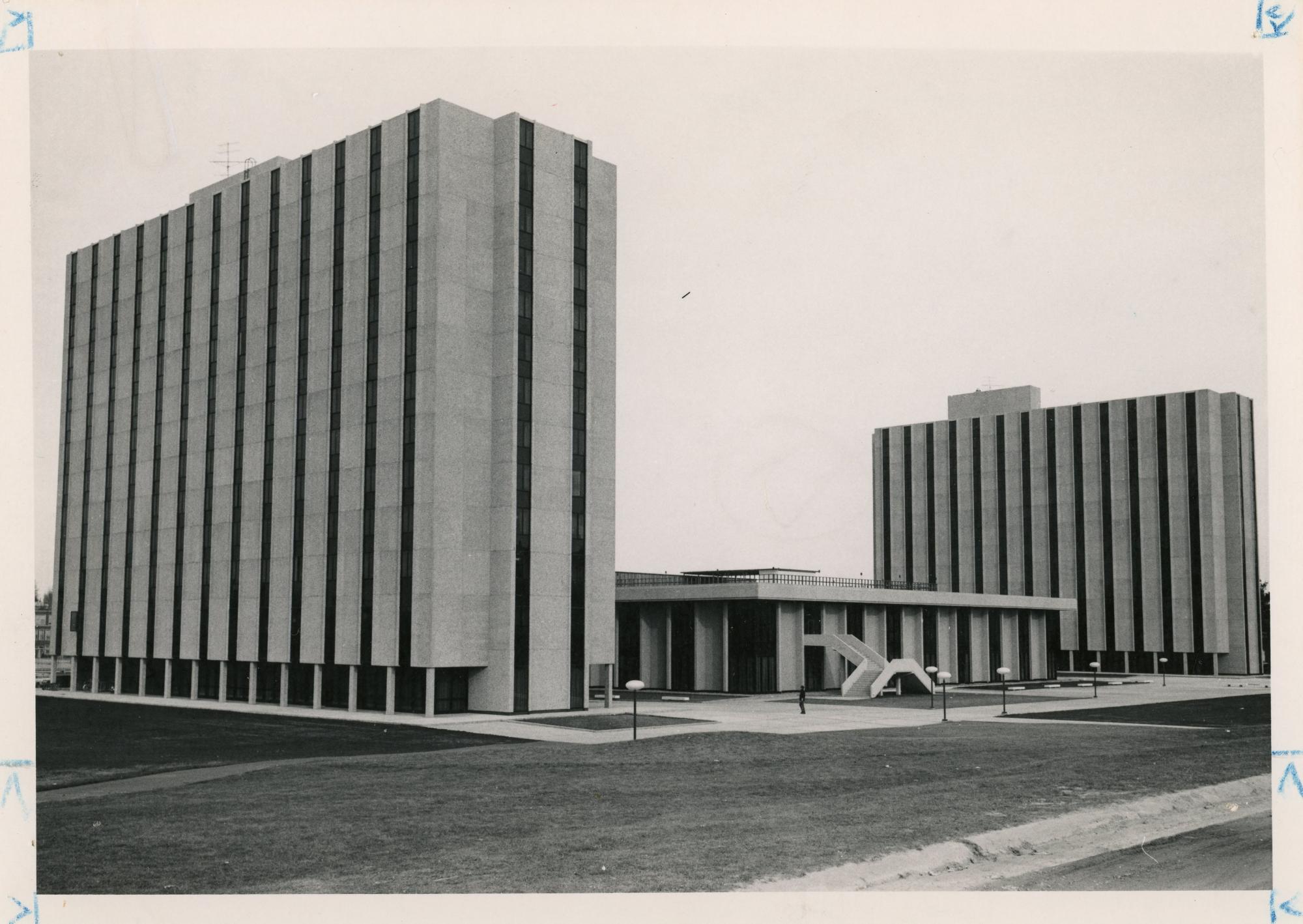
The Towers Complex is a community landmark. The sheer height of Bender Hall and Dancer Hall makes the complex the dominant architectural feature on the west side of Cedar Falls. While the complex is interesting as a collection of buildings, built in a certain place and at a certain time, it is also noteworthy as the home of generations of UNI students. Developing traditions and making the buildings good places to live has been the work of these students over the forty year history of the complex. This essay takes a look at the way that the complex was planned and built and then at both the enjoyable and the difficult times that its residents have experienced. But, most important, it will tell how the residents and UNI administration worked together to improve the quality of life in the complex.
Planning and Construction
The history of the planning and construction of the Towers Complex is complicated and confusing. This is at least partially due to the problems that college and university administrators faced in dealing with the extraordinary enrollment surge in the middle and late 1960s, when the Baby Boomers began to reach college age. In Cedar Falls, the quiet Iowa State Teachers College, with an enrollment of 3616 in 1960, became the University of Northern Iowa, with an enrollment of 9723 in 1970. Accommodating six thousand additional students in just a decade was a daunting task for a public institution such as UNI, where all building projects needed to work their way through levels of bureaucracy and then compete for attention with other worthy projects in the Iowa General Assembly.
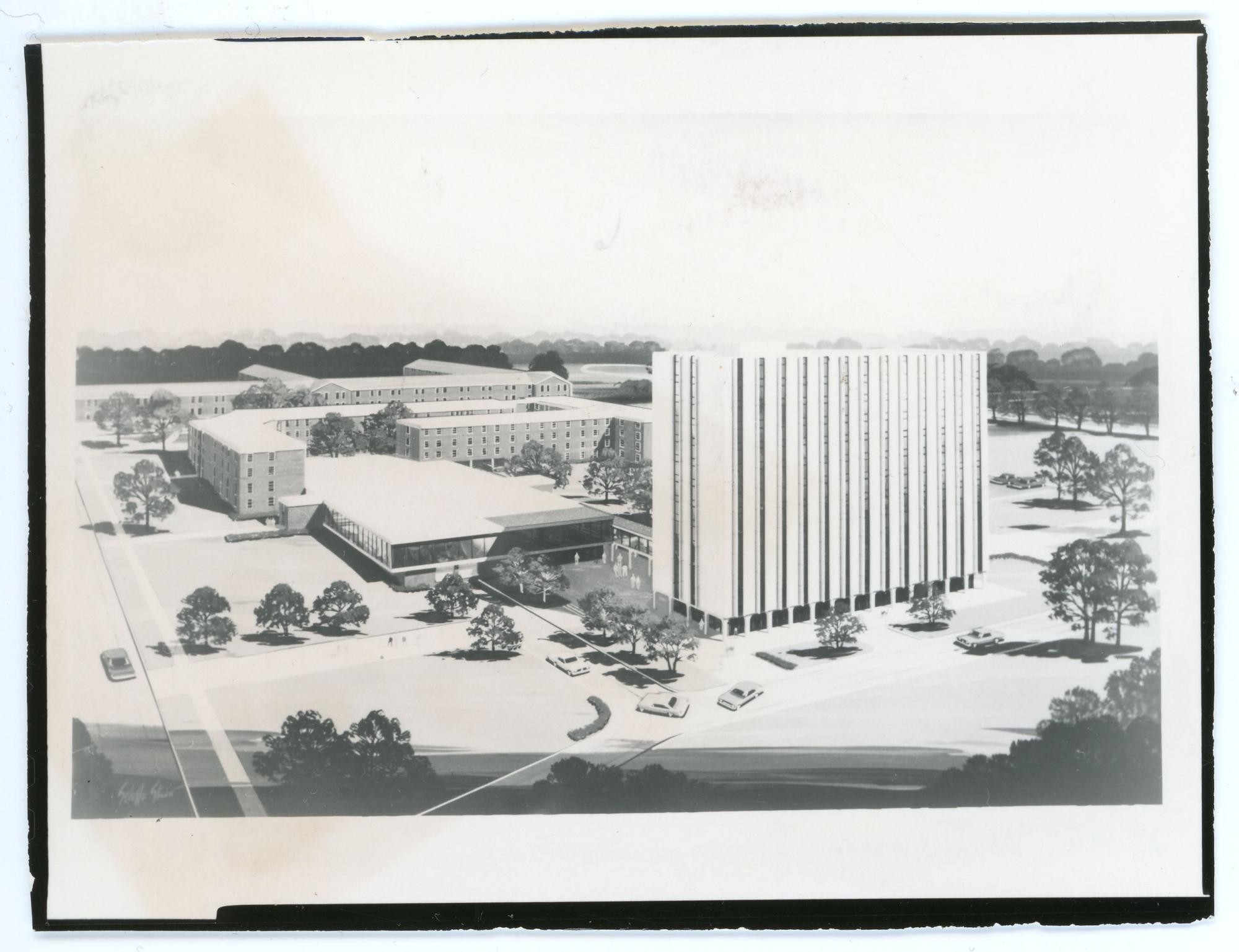
The Regents Complex, built in the middle 1960s and consisting of Noehren Hall, Hagemann Hall, Shull Hall, and Rider Hall, was the first significant housing project developed by the college to meet the needs of the surging enrollment of the 1960s. But there was a clear need for even more on-campus housing than the Regents Complex provided. At their January 1966 meeting, the Board of Regents authorized planning for a $2.8 million dormitory with accommodations for six hundred students. The dormitory would be built north of Campbell Hall and would be connected to Campbell Hall by means of an expanded and shared dining facility.
Details about the new dormitory emerged in the spring of 1966. The building would be a fourteen story high rise for men. Construction would start in November 1966, and, with luck, would be available for occupancy for the fall semester of 1967. Architects and campus officials debated whether the building would be of the traditional red brick and limestone style or a more modern look with concrete, steel, and glass. There also began to be speculation that there would be a second high rise built northwest of Campbell Hall and the new dormitory.
Reactions to plans for the new building were not entirely favorable. Professor Josef Fox wrote in the student newspaper, The College Eye, that there did not seem to be any compelling reason to build a high rise in a place like Cedar Falls. He said, "I simply cannot understand a mind that wants to build a skyscraper in the middle of a cornfield." Professor Fox called for a meeting on the matter, but only a few students, faculty, and administrators attended. The planning administrators who did attend were ready to defend their recommendations. They pointed out that the location and the relatively smaller footprint of a high rise building would save space for instructional buildings on the central portion of campus. The design of the new dormitory would feature a single central hallway that would limit the disruptive pass-through traffic of other campus buildings. They also pointed out that using caissons in the construction of the foundation would be more economical than using the continuous footings of traditional buildings. They believed that the individual floors of the high rise would bond into functional social units.

In May 1966, the Regents approved preliminary plans for the new high rise dormitory, even though one Regent called it "a shock to the skyline". It would be white concrete with vertical lines and tinted glass. The building footprint would be 50 feet X 150 feet, with rooms of 12 feet X 14 feet. Instead of the original fourteen levels, the plans now called for thirteen levels. Smith, Voorhees, and Jensen Architects Associated of Des Moines had shaved one floor off the original plan to make the project fit the $2.88 million budget. For the same reason, the architects eliminated lavatories in rooms, though these would re-appear in later plans. Final plans would go to the Regents in September, followed by a thirty to forty day window for bids. The building was to be completed in eighteen months, or by spring 1968.
But in October 1966, UNI officials had changed their minds. They told the Regents that they did not believe that a single building would meet anticipated enrollment growth. They proposed to build a second identical tower. The plan to share dining facilities with Campbell Hall was abandoned. The two high rises would be developed in a new complex with its own dining center. What's more, the dining center would have the capacity to serve a third tower in the complex. The $25,000 already spent on planning a shared Campbell Hall dining center would be lost, but there would be a significant amount of money saved by using the same plan for the second tower that had already been developed for the first tower. The Regents approved preliminary plans for this altered arrangement and budgeted $6.15 million for it. In an interesting sidelight, one Regent, William Quarton, said that it was time for UNI to seek some serious help with its campus planning.
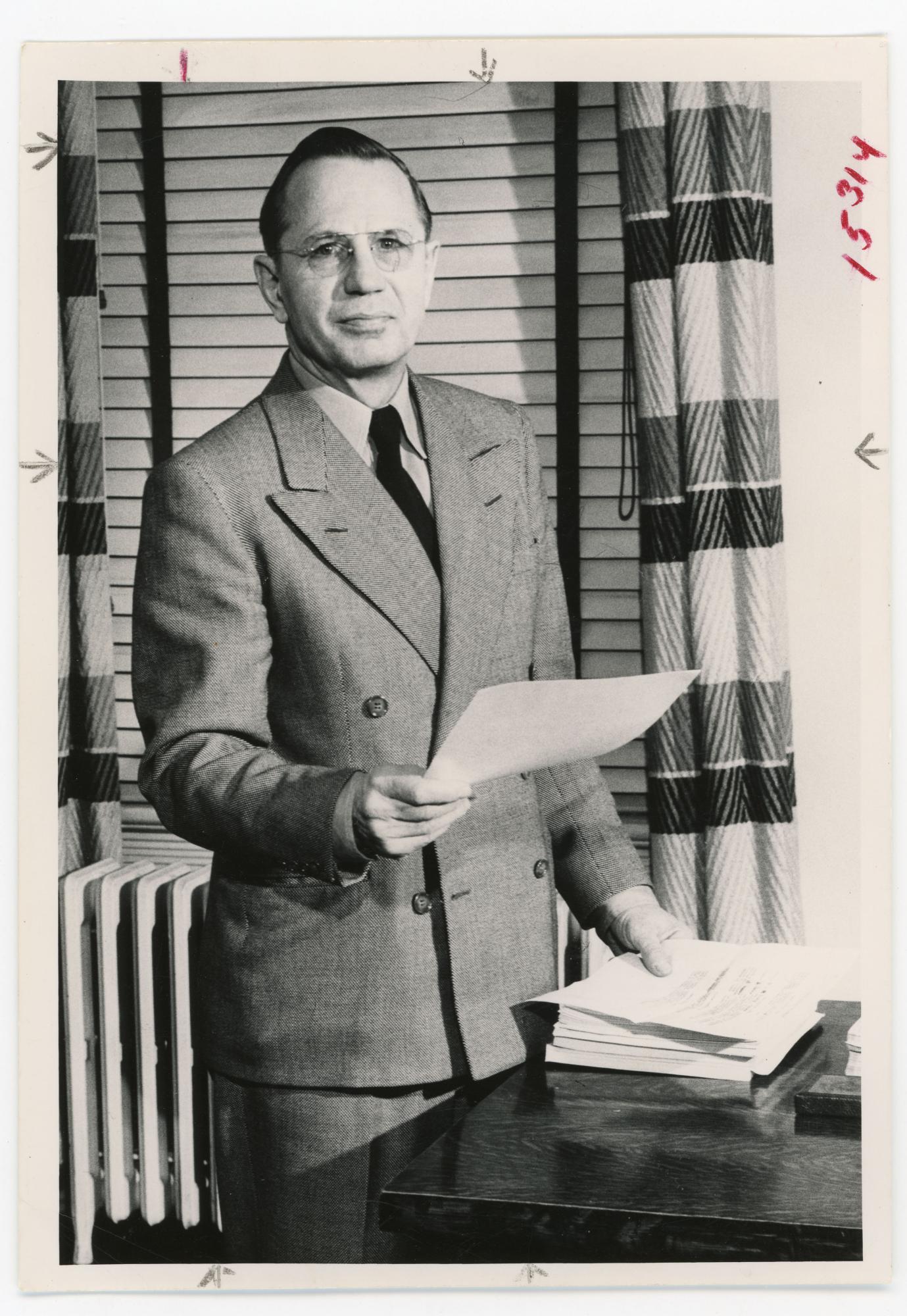
In February 1967, the Regents approved final plans and a budget of $6.2 million for a complex consisting of a dining center and two thirteen level dormitories, each accommodating about six hundred students. Construction began that same month, with hopes for a fall 1968 completion. In July 1967, the Regents approved an increased budget of $6.32 million. In August 1967, they gave the name Towers Complex to the project; they also decided to honor their long-time secretary, David A. Dancer, by naming the east hall after him.
On November 9, 1967, the Regents approved the naming of the west tower in honor of Paul F. Bender.
Professor Bender was a member of the faculty from 1921 through 1964. He was Dean of Men from 1948 until 1952 and Dean of Students from 1952 until 1964. Bender also coached track, wrestling, and football at different points during his career at UNI.
By the fall of 1967, construction was progressing reasonably well on the towers and the dining center, but UNI asked the contractor to make a special effort to complete at least the west tower by fall 1968.
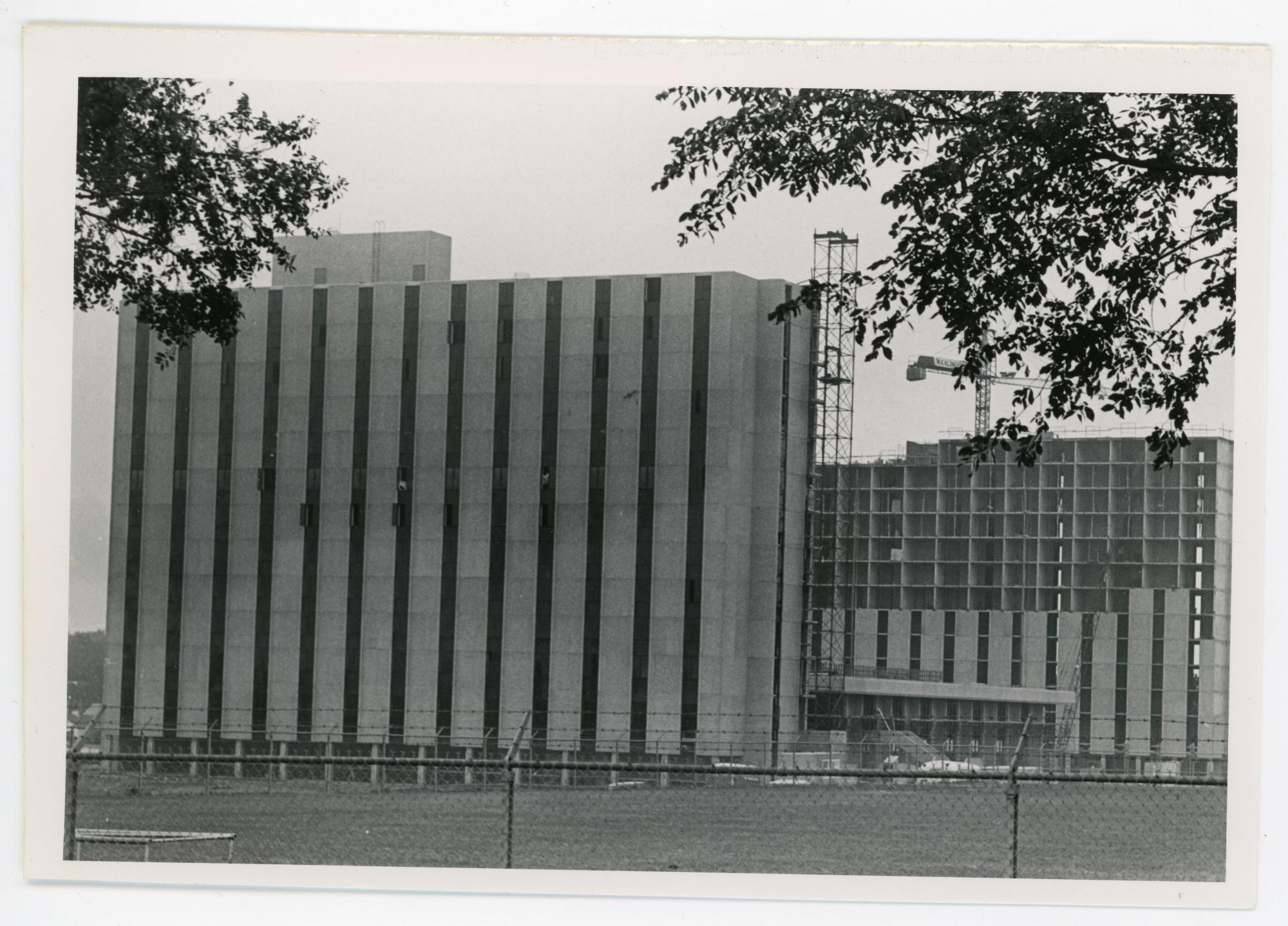
There was also still talk of a third tower. Marshall Beard, Registrar and planning administrator, stated that "A third dormitory to house 800 students is in the planning stage."
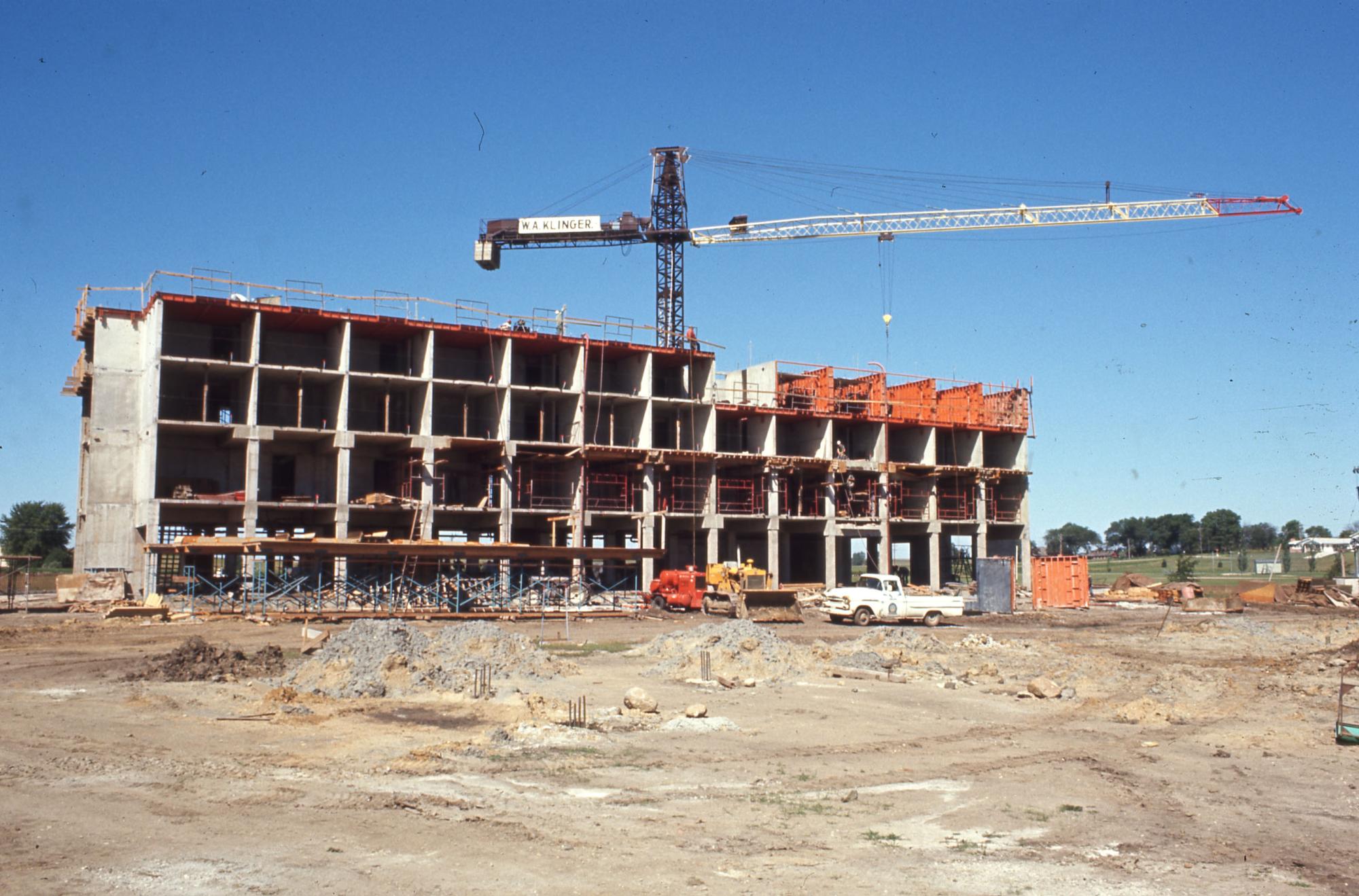

But contractors ran into obstacles. On February 12, 1968, about seventy-five UNI Physical Plant workers walked off their jobs for two hours. On February 20, nearly all of the Physical Plant workers struck and set up picket lines. Workers on the Towers project refused to cross the picket lines and construction stopped. On February 24, the university obtained a temporary injunction that limited picketing, and work on the Towers got back underway.
Brisk March weather also played a role in construction delays; exterior and roof work could not be done when there were high winds. And, on March 14, there was a small fire that damaged wiring and hoses in a part of the project. With prospects for fall 1968 occupancy growing dimmer, UNI administrators began to make contingency plans for student housing. Daryl Pendergraft, Assistant to the President, stated that the university was considering tripling existing dormitory rooms, using recreation rooms, or even locating housing off campus for the first few weeks of the fall 1968 semester. There was also the possibility of occupying completed floors in the new building, while other parts were still under construction.
The fall 1968 semester arrived and neither of the high rises was complete. The occupancy date for the west tower, the men's unit, was predicted to be mid-November or December. Dancer Hall, the women's unit, was predicted to be ready for occupancy by June 1969. As a result, Baker Hall, then still serving its original function as a dormitory, was 75% over capacity; Rider and Shull Halls were 55% over capacity. Twenty-three women lived in the lofts of Bartlett Hall and Lawther Hall. Officials still puzzled over how to handle the transition to the new dormitories.

At one point, officials planned to make the west tower a co-ed dormitory at least until Dancer Hall was completed; 307 men and 216 women would live there. But those plans never came to fruition. Even though most of the building was still under construction, two hundred men moved into floors nine through twelve of Bender Hall in January 1969. The new residents had no phones and shared elevators with construction crews, but most found the building luxurious and roomy after being crammed into tight quarters during the fall semester. Bad weather slowed work on the dining center, so residents went to the Commons for their meals.
In April 1969, the Cedar Falls Fire Department stated that it believed it to be hazardous to allow residents to occupy the top floors of Bender Hall while the bottom floors were still under construction. Especially in the late 1960s, when radical action, including arson, was a threat on many campuses, life safety issues deserved serious consideration. But apparently the university took adequate precautions to satisfy the Fire Department.

The matter of a third tower continued to move along. In March 1969 the Regents authorized UNI to begin negotiations with an architect for a third Towers Complex housing unit. The third unit would be similar in design to the first two units.
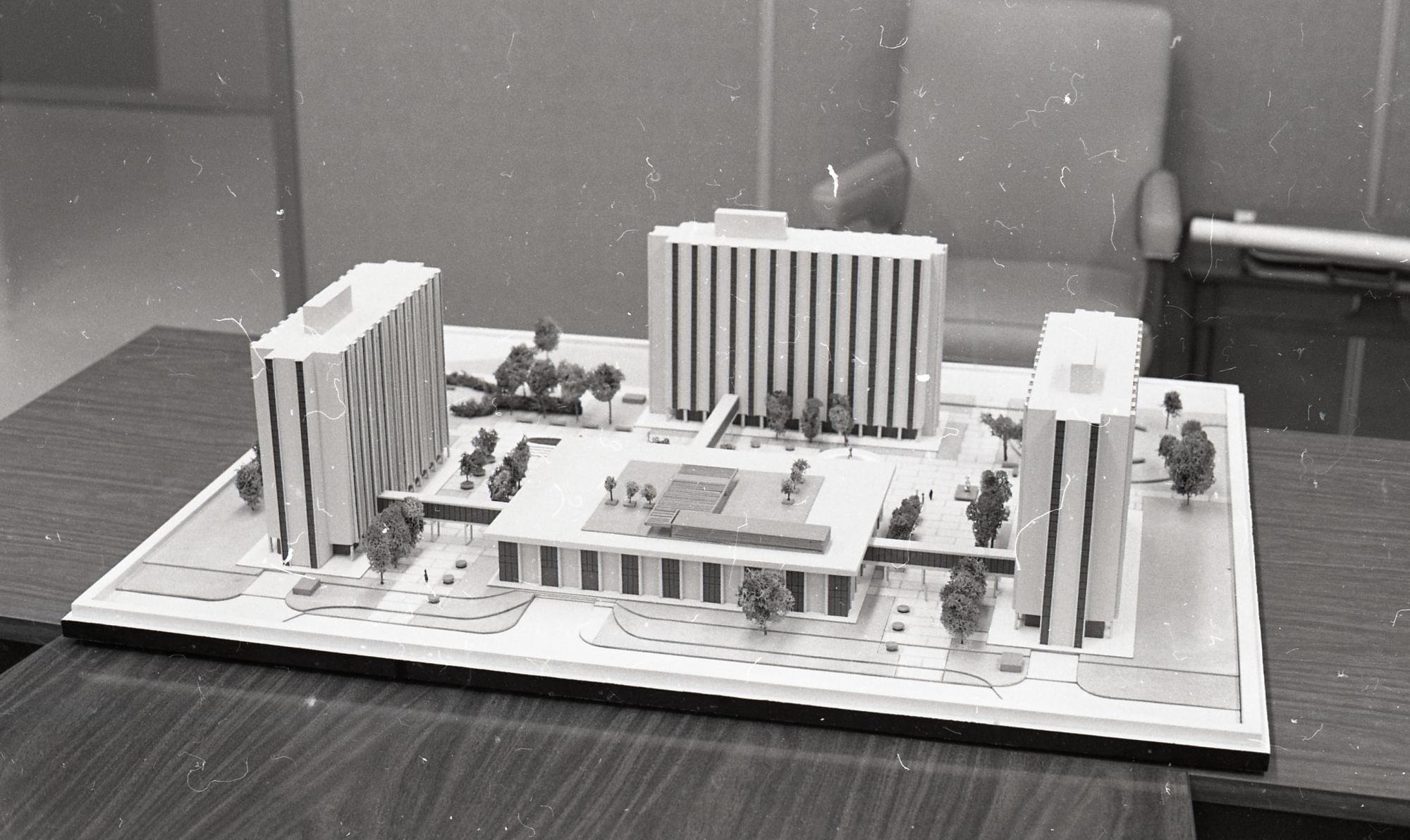
It would cost about $2.9 million and be situated on the south side of the complex. But by September 1969, UNI officials had begun to have serious reservations about the need for a third unit. They cited rising construction costs, a potential decline in enrollment, changing regulations regarding student residence requirements, and changing attitudes toward living in dormitories. They wondered seriously if an additional unit would be occupied at a rate that would pay off the bonds needed to finance such a project. Consequently, President Maucker proposed, and the Regents approved, a one year moratorium on dormitory construction. During that time, the university planned to study needs, attitudes, preferences, and the effects of more liberal policies regarding required residence in dormitories. A third tower seems never to have received serious attention after that; it was destined to become one of the university's "phantom facilities".
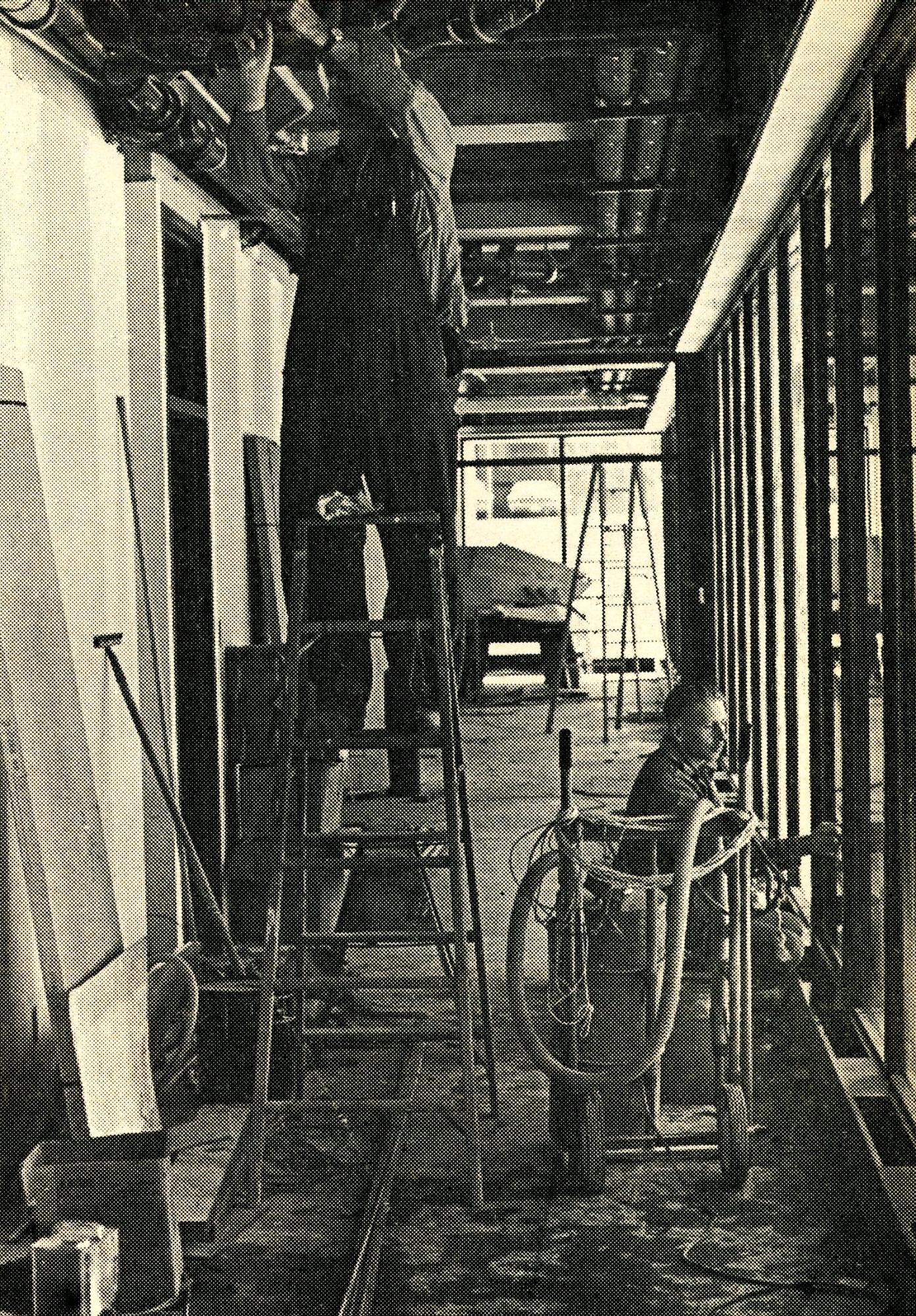
Bender Hall was completed for the fall 1969 semester. The completion date for Dancer Hall was predicted for November 1, 1969. There were 234 women tripled in Bartlett, Lawther, and Campbell Halls. An additional two hundred women were housed temporarily in Baker Hall.
Difficulty in finding appropriately skilled workers to install the Dancer Hall ventilation system led to further delays. The completion date was moved back to the start of the spring 1970 semester.
Even though Dancer Hall was still incomplete at the time, the university held a Towers Complex dedication ceremony on October 26, 1969, in the Towers Center. David Dancer and Paul Bender, who together had devoted over sixty-five years of service to Iowa education, spoke at the ceremony.
At the beginning of the spring 1970 semester, women finally moved into Dancer Hall. Each of the new buildings had 314 rooms, with total accommodations for 606 students. There were eleven residential floors with the lowest two levels devoted to service, recreation, and administrative functions. Rooms were carpeted and featured some built-ins, but the furniture was moveable to allow for flexibility in arrangement.
The residents of Bender and Dancer Halls quickly found ways of getting to know one another. The Bender Hall men held a get-acquainted party with a casino theme for their Dancer Hall counterparts, shortly after the women moved in. And, just a couple of weeks after Dancer Hall was occupied, the Northern Iowan reported on an all-too-familiar aspect of dormitory life. On February 12, 1970, at about one o'clock in the morning, someone tripped a false fire alarm in Bender Hall. Men trooped down the stairs and out into the cold night in something less than warm clothing. Then someone set off a fire sensor in Dancer Hall. Six hundred women joined six hundred men in crowds milling around the buildings.
Struggles Over Living Arrangements
For at least some residents, life in the Towers Complex during the 1970s seemed to be dominated by a continuing battle over living arrangements. Dormitory complexes developed during the early and middle 1960s often featured separate buildings for men and women, though the complexes might share dining and recreation facilities. But the more liberal attitudes that grew up among students in the late 1960s led to an expectation of even closer contact between men and women. The battle that played out on the UNI campus had at least three distinct elements:
- "co-ed" arrangements involving both men and women living on the same floor;
- 24-hour visitation;
- "layering", or alternating floors with men's and women's units.
While each of these elements was distinct, agitation for several elements sometimes occurred simultaneously, and, occasionally, one at the expense of another.
Co-ed Arrangements

In the spring of 1972, the Student Senate recommended that the second and third floors of Dancer Hall should house both men and women: men would live on one side of those halls and women would live on the other side. The current residents of those two floors would be asked to find other accommodations, unless they chose to apply to live under the new arrangement. Men and women would apply to live on the Dancer Hall co-ed floors; successful applicants would be selected at random. Applicants would need to be at least nineteen years old and have lived in a UNI dormitory for at least one semester. After strong debate, the UNI Administrative Council narrowly approved the recommendation, 10-9, and then the Regents approved it, 5-3. The plan was implemented in the fall of 1972. The residents seemed to adapt well to the new situation. Regular surveys found that the residents favored the arrangement and liked the "friendly, unguarded atmosphere".
However, despite the initial effort and controversy involved in establishing the two co-ed floors, interest in that arrangement waned. As early as spring 1973, a Dancer Hall woman wrote to the Northern Iowan urging students to sign up for the co-ed arrangement. These sorts of appeals appeared regularly in the student newspaper over the next several years. Apparently students living in other parts of the residence hall system had established loyalties to their own units and did want to switch, because they did not know the strength of the university's commitment to the co-ed living arrangement. By room sign-up time in the spring of 1975, residence hall administrators announced that if there were not a significant increase in the number of students requesting the co-ed arrangement, third floor Dancer would be converted back to a women's floor. The administrators argued that the switch would be a matter of fairness: the relative lack of interest in co-ed living resulted in a single occupancy rate of about 80% on those two floors of Dancer Hall. Across campus the rate was about 20%. Signing up for the co-ed arrangement provided a strong chance of getting a single room. The president of Dancer Co-ed, as that area styled itself, stated that she believed that the university was deliberately under-publicizing this living arraignment. She noted that UNI housing literature called Dancer Hall a women's dormitory, without describing the Dancer Co-ed option.
Layering and 24-Hour Visitation

In January 1976, the Residence Hall Association proposed a new living arrangement for the Towers Complex. Generally termed "layering", this arrangement would exchange the odd-numbered floors of Bender and Dancer Halls; the result would be alternating floors of men and women in the two buildings. Dancer Co-ed could remain as it was, if there were sufficient interest in maintaining it. Indeed, if interest were strong, the second level of Bender Hall would become co-ed. At the same time, the issue of 24-hour visitation came to the forefront. In its broadest terms, 24-hour visitation allowed men and women to visit each other's dormitory rooms at any time. In practice, various limitations were considered: that is, limiting the policy to certain dormitories or to certain days of the week or to require an escort to bring the guest to the floor that he or she intended to visit. The matter produced strong confrontations and debate between students and administrators. In the end, President Kamerick approved a policy that would allow 24-hour visitation, on a two-year trial basis, for two residence halls. A hall would need to approve the policy by a two-thirds majority vote in order to be considered for participation. Rider Hall and Dancer Hall were selected at random to be the two 24-hour visitation policy trial units.
The layering proposal also continued to be debated. The Residence Hall Association again made their proposal in December 1977 and arranged for a January 1978 vote. With a two-thirds majority needed, Bender Hall responded with an 88% vote in favor of layering, while Dancer Hall voted just 59% in favor.; Certain Dancer Hall residents petitioned for a second vote, and, in the second balloting, Dancer Hall registered a 68% favorable vote.
The Dancer Hall Co-ed unit ended at this time: in the fall of 1978 it reverted to its former women-only arrangement. It was probably a victim of many factors, including lack of publicity and university commitment, lack of interaction with other housing units, and the attraction of the more liberal housing policies of layering and 24-hour visitation.
Safety
As might be expected in any large housing unit, the Towers Complex has seen its share of unfortunate events that threatened the safety of its residents. There have been several serious fires and crimes over the years. In February 1977, two men, who brandished a gun, were arrested for the robbery of several residents on the tenth floor of Bender Hall. In 1973, a fire was discovered in an overstuffed chair in a Bender Hall room. When the fire was extinguished, and on the basis of what they found in the room, officials arrested the room's residents on drug possession and manufacturing charges.


In the summer of 1980, a student in Dancer Hall apparently awoke to find a chair in his room on fire. In order to flee the flames, the confused student went to his sixth floor window and fell to his death.


Later in 1980 someone apparently set fire to bulletin boards in Dancer Hall; the fires and consequent water damage from the fire-fighting efforts caused significant losses. In the spring of 1992, home-made bombs exploded on several occasions on the ninth floor of Bender Hall. There were no injuries and only minor damage from those explosions. In 1999, an unattended candle in a Dancer Hall room caused a fire that resulted in about $60,000 in damage.
Other more minor fires and repeated false alarms have also plagued the residents.
Vandalism and petty crime have been recurrent problems for the Towers Complex. Restrooms and elevators were the frequent targets of vandals.

At times, one of the two elevators would be out of order for several weeks, and, in order to keep one unit running, the functioning elevator would be shut off on weekends, when most of the vandalism apparently occurred. Also, with more liberal visitation policies, people from outside the housing units seemed to find their way into the buildings and do mischief.
Both students and university administrators worked to counter the threats posed by fire and criminal activity. Nearly every serious fire brought concerns from students who worried about their safety in a high rise building. They asked how they could be safe, when local fire departments ladders reached only to about the sixth or seventh floors. Administrators pointed out that the rooms in the Towers Complex have five inch thick concrete walls, floors, and ceilings, as well as substantial fire-rated doors. They noted that in even the most serious fires in the complex, flames were confined to a single room. UNI has improved fire detection systems and worked on fire prevention programs over the years. Following the fire caused by an unattended candle in 1999, the Department of Residence prohibited the possession of candles in the residence halls.
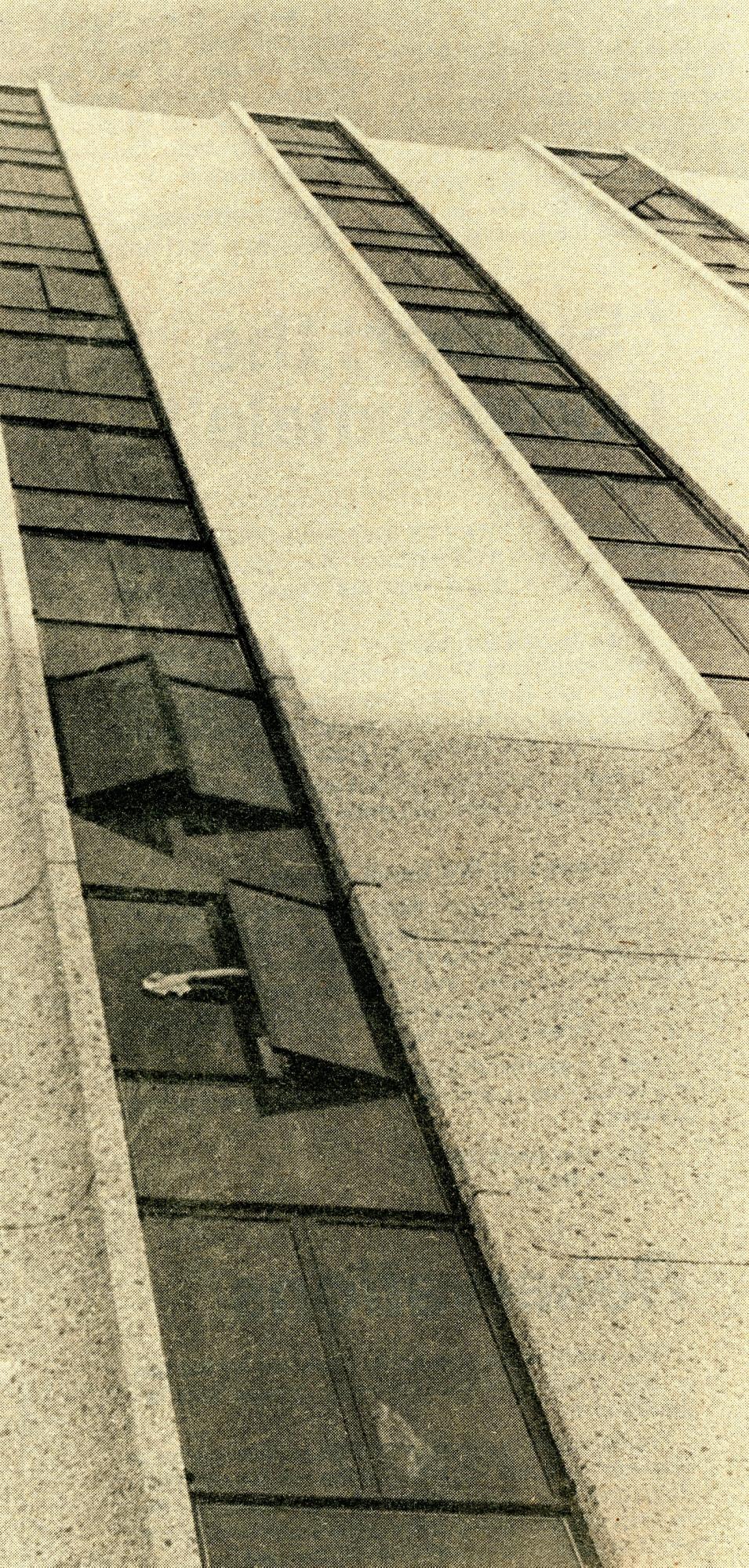
Towers students and administrators have taken a variety of measures to deal with vandalism. In 1978, hall senates set up a $50 reward for information leading to the apprehension of vandals. And, one of the selling points for the layering arrangement outlined above in this essay was the hope that layering would lead to a decrease in rowdiness, noise, and vandalism. In short, it was hoped that the relative proximity of women would lead men to behave better. In 1981, the Dancer Hall coordinator urged hall government and resident assistants to take more responsibility for the appearance of their units.
He said that there should be no room for sympathy for the actions of drunken vandals. In 1983, a program in Bender Hall similar to Neighborhood Watch led to substantial reductions in theft in that hall.
To help deal with problems caused by people from outside the Towers Complex, residents worked with the administration to gain better control of access to the buildings. In 1985, Dancer Hall residents volunteered to serve as night assistants on weekends. By checking keys and IDs and keeping non-residents out of the building, they hoped to reduce loitering, vandalism, and theft.
The university has also worked on several different key and lock programs to keep residents safe from intruders. In 1994, for example, residents of several floors in Bender Hall proposed that doors to their floors by keyed. They hoped that this measure would help stop vandalism and break-ins that had left their floors in debt for damages.
Towers residents also attempted to improve security outside their unit. In the fall of 1983, about twenty-five Bender Hall residents established a campus escort service and merged it with a similar operation developed by Shull Hall residents several years earlier.
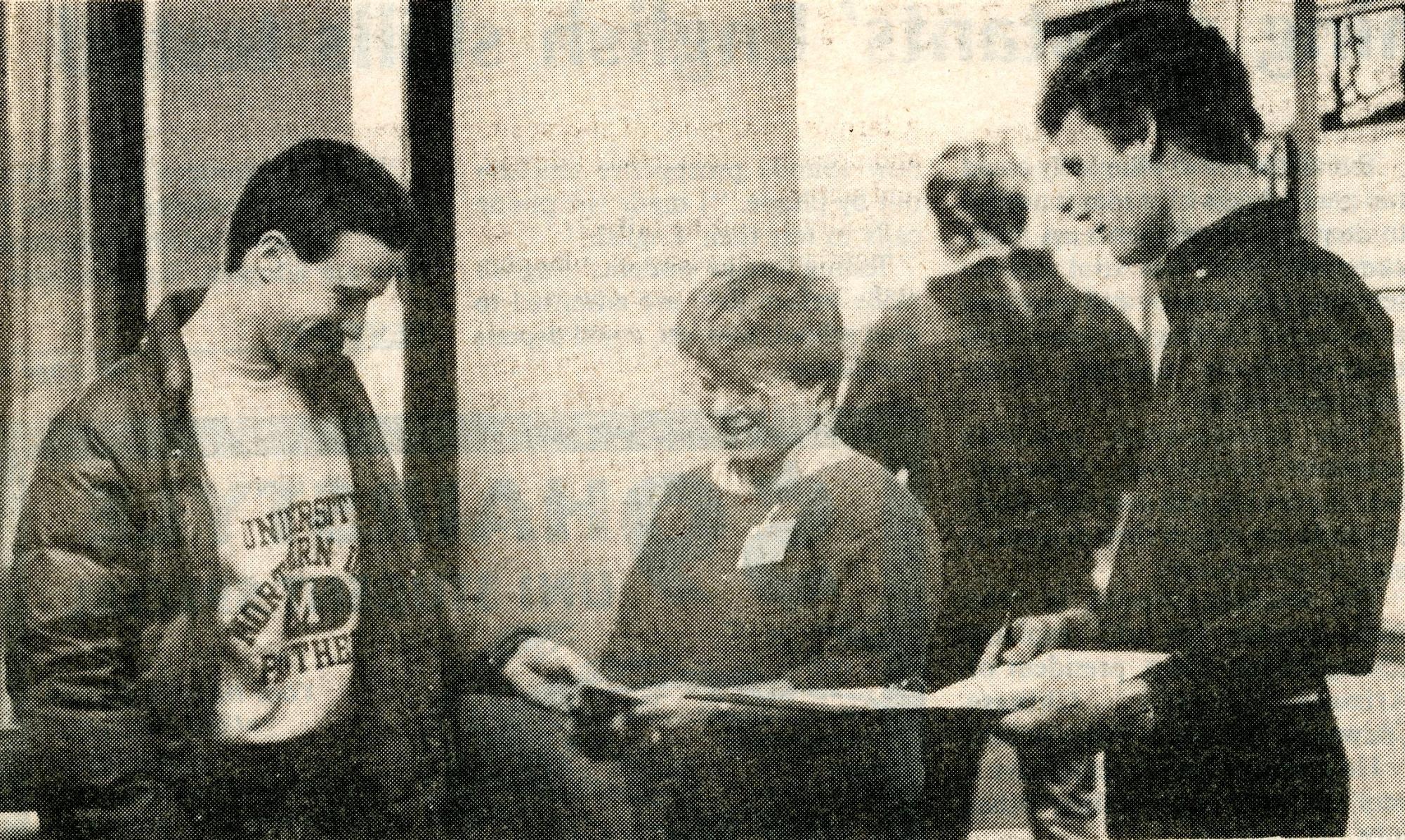
Renovations and Improvements
The Towers Complex has undergone many minor and several major renovations over its forty year history. As early as 1976, crumbling steps around the Towers Center needed replacement, due to problems with the amount of aggregate used in the original concrete work. Bender Hall underwent a round of renovations just before the layering arrangement was implemented in the fall of 1978. Repairs were made and new carpet and furnishings were installed in parts of the hall. In 1982, the Towers Center received roof repairs as well as some new carpet and paint.
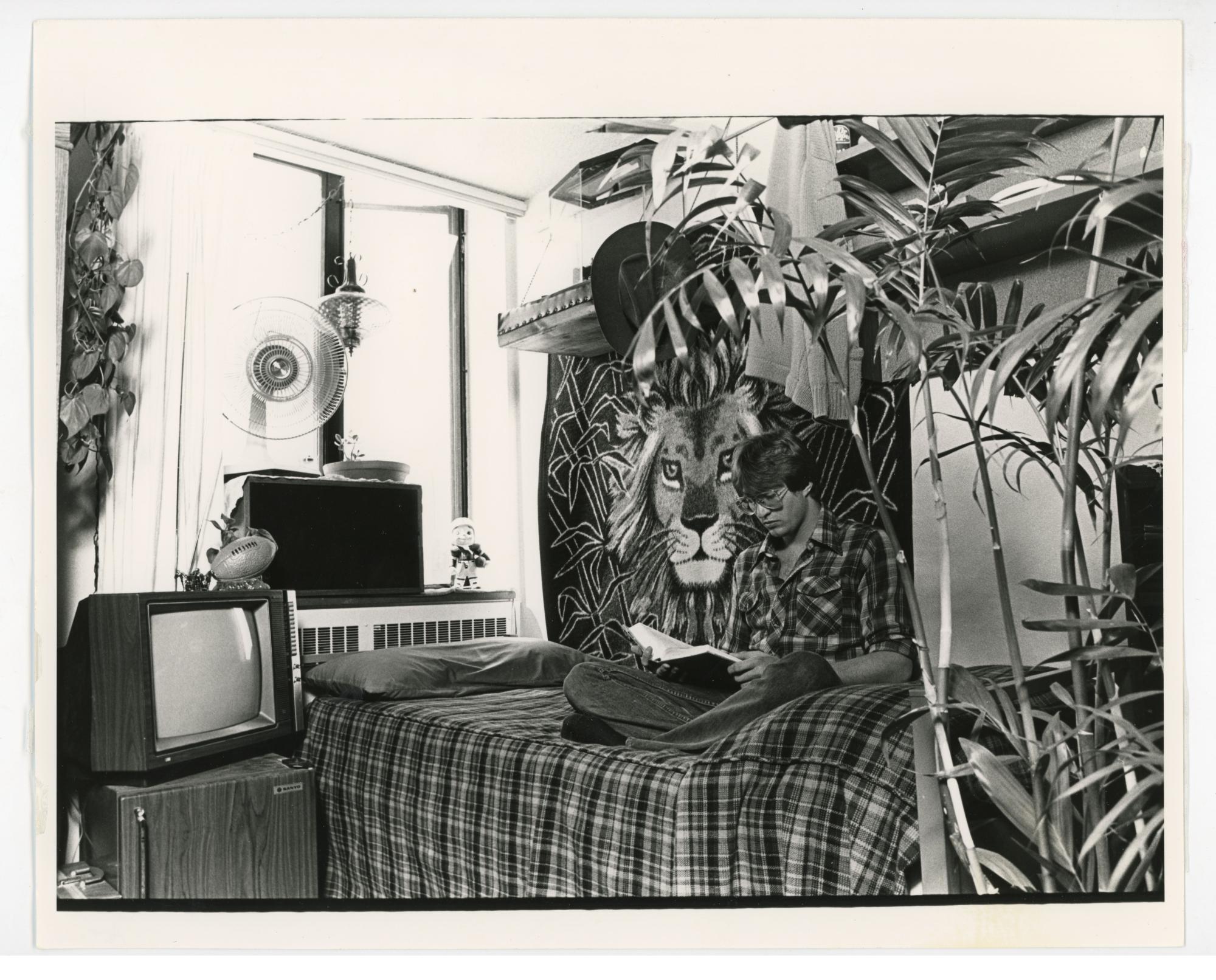
In that same round of work, Bender and Dancer Halls received new corridor carpet on some floors. Work also began on an emergency power system and, in keeping with new state mandates, on the installation of smoke detectors in every room by an August 1984 deadline. In August 1987, a computer lab opened in the Towers Center. This lab included forty-two computers, twelve of which were networked. Three of the computers had 20Mb hard drives, impressive power for those days. The lab cost about $75,000; one third of that money came from residence hall funds and two thirds came from student fees.
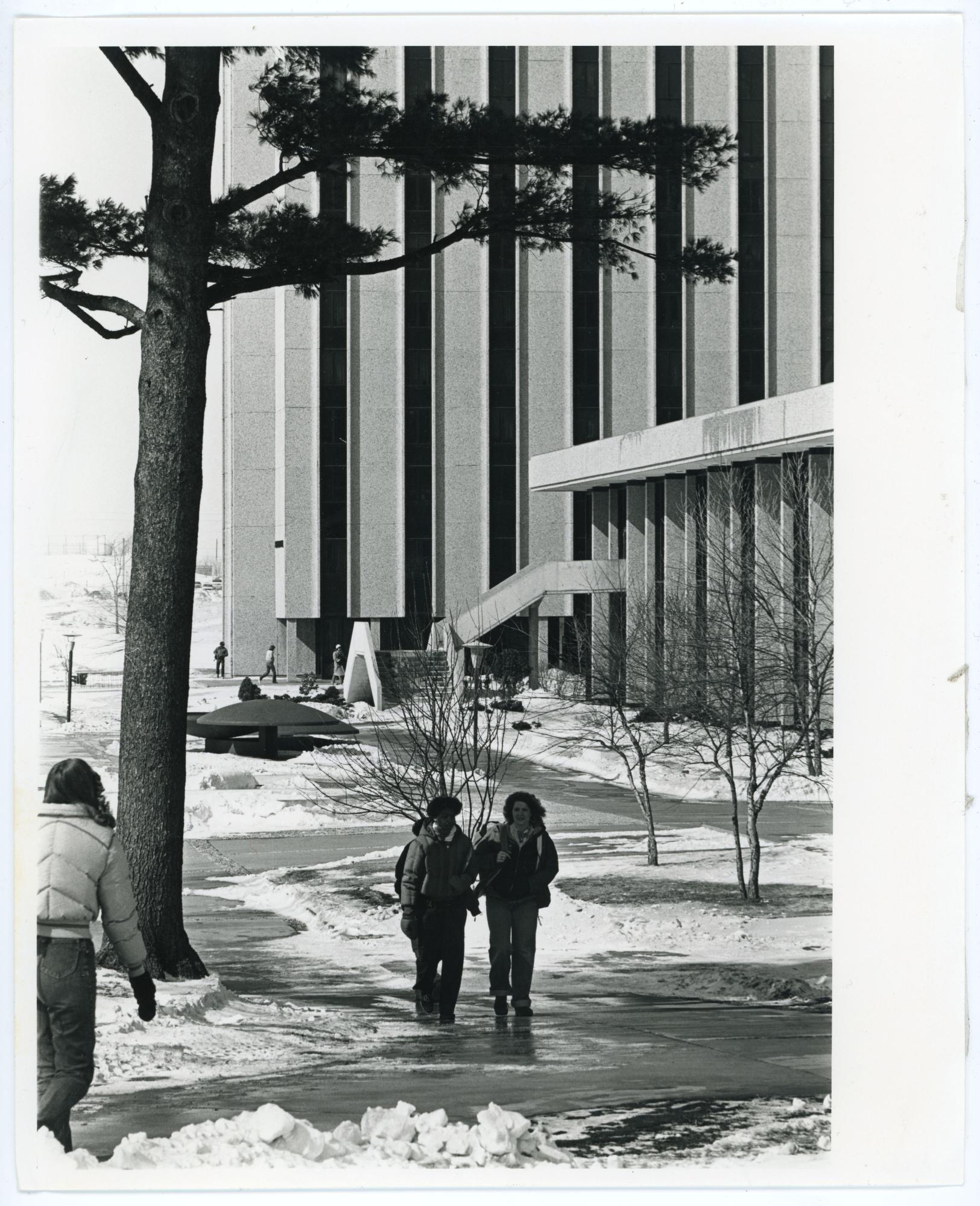
Window seals proved to be a persistent maintenance problem. Some Bender Hall residents complained in 1992 that their windows leaked so badly that rain pooled on their carpets. Several large projects aimed at solving this problem. In the summer of 1995, the pedestrian bridge in Towers Center was replaced. In 1997, new data and communication lines were installed in anticipation of network connections in residence hall rooms. In January 1998, an ATM was installed near the Towers Computer Lab. In November of that year, seventy mile per hour winds blew portions of the Bender Hall roof membrane loose so that, for a time, it hung down to the sixth floor. The membrane eventually tore loose and fell to the ground. Damage, estimated to be about $75,000, was repaired in several days. Work began on exterior repairs and a two year project on plaza improvements on the Towers Complex in the summer of 1999. The work on the plaza would include more landscaping and less concrete. There would be an outdoor seating area and dining pavilion to be used during clement weather. On December 26, 1999, a transformer on the roof of Bender Hall exploded and caused damage to the transformer housing.
There was an $8.5 million renovation of Towers Center during the 2003-2004 school year. The Campbell Hall dining facilities opened for one year while the work was under way. The new Towers Center was organized along the "marketplace" arrangement similar to that of Redeker Center. The Center received new equipment and a new HVAC system. Bids for the were let in the late fall of 2002.

Life in the Towers
But there was a great deal more to life in the Towers Complex than grim policy struggles, concerns over safety, and wondering when the windows would be fixed. The Complex developed its own facilities for the comfort and recreation of its residents. It also began to develop its own traditions and to connect with the rest of campus and the wider community. Most students enjoyed living there.
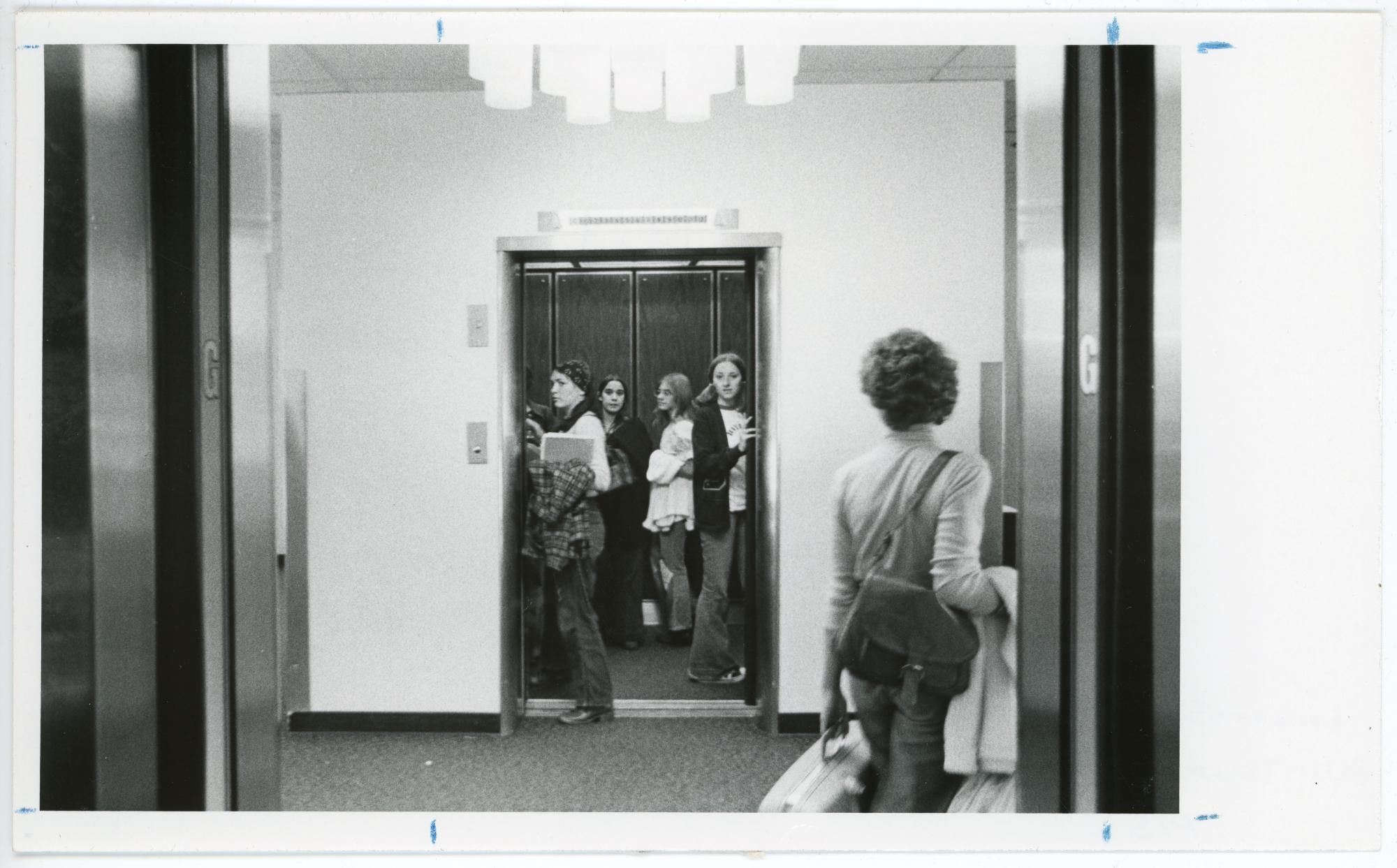
In 1971, the University Library set up a small satellite operation in the Towers Complex. The collection in this satellite unit initially consisted of extra copies of heavily-used reserve books. This arrangement made life more convenient for Towers residents and took pressure off the use of books at the regular Library Reserve Desk. The little library was open Sunday through Thursday evenings and was staffed mostly by volunteers. Over time, the library grew to include novels, dictionaries, magazines, records, games, test files, and college catalogues.
Residents and Towers staff got acquainted and found that they liked each other. At Christmas 1971, head cook Beulah Eastman sent the following poem to the Northern Iowan:
We, the people at Towers have our duties to perform.
We cook and bake, and stir and blend,
For our friends, out in the dorm.
We try our best to please them all, for this is our desire.
We wash all their dirty dishes, and do all that is required.
Altho we get a fee for this, it's all done with tender loving care.
For all you lovely people, going up and down our stair,
There is no generation gap, we try to have an answer.
For the faithful men and women, living in Bender and in Dancer.
We think you are the very best. You people of UNI.
That is why we send you this greeting, as this year goes fleeting by.
In several early instances, Towers residents learned to defend their own turf. For example, they opposed the construction of a gravel parking lot west of Bender Hall. They cited the potential for dust as well as for noise at all hours of the day and night. They also opposed a plan to close dining facilities in the Commons and Campbell Hall on weekends and to shift those residents to the Towers dining facilities.

In October 1972, residents of Bender and Dancer Halls sponsored bed races in which four residents would ride and four would push.
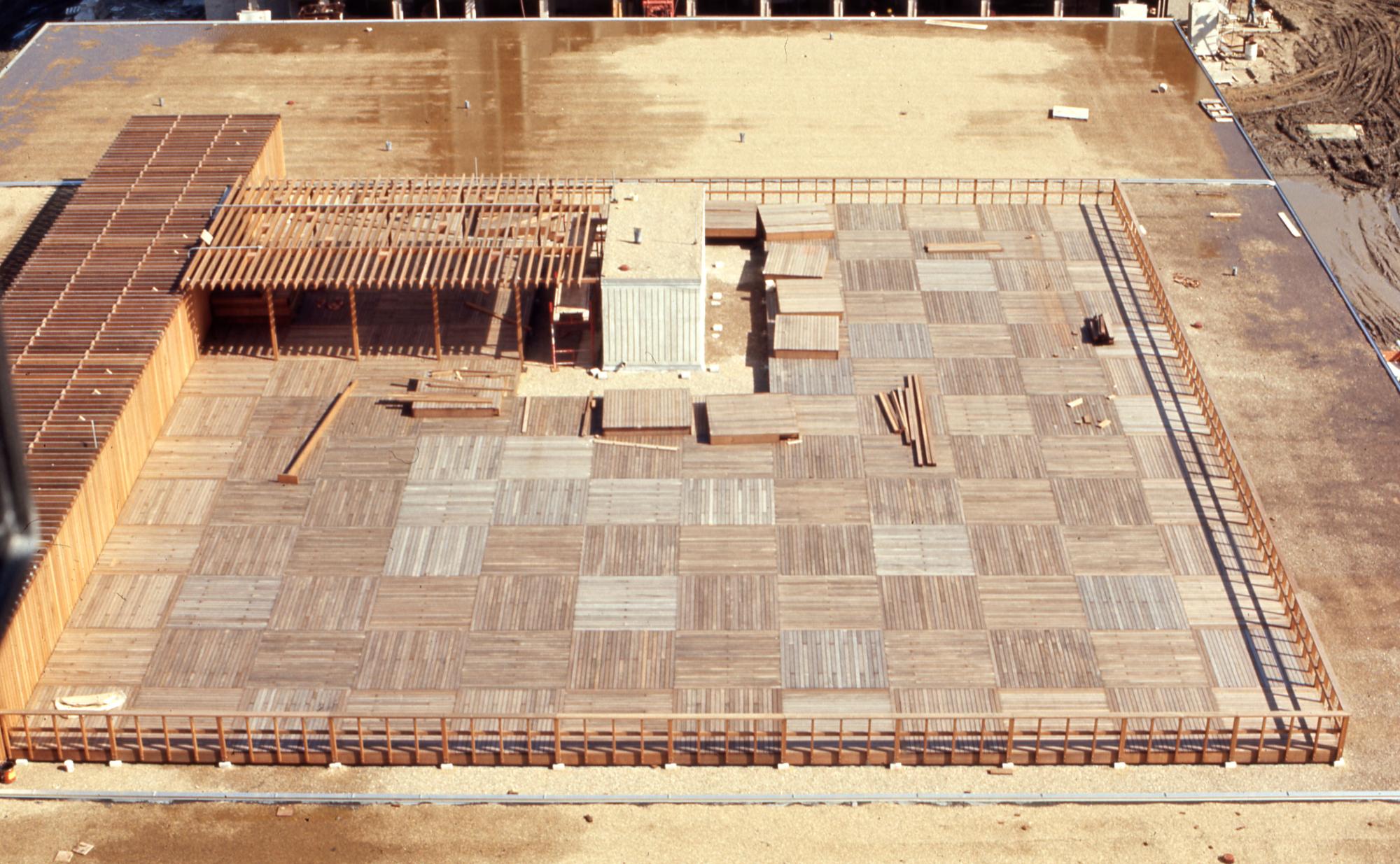
A writer in the Northern Iowan in the summer of 1973 gloried in life at Towers. She cited the interesting students of all ages, generous visitation hours, and the opportunity to observe sunbathers on the sundeck.
During the fall semester of 1974, the Complex offered a Halloween extravaganza complete with movies and costumes. This event was probably planned in vain hopes of deterring another unfortunate Halloween tradition, the Towers food fight. At Christmas that year, Bender Hall featured its huge Christmas tree-shaped display by lighting selected rooms on one side of the building. The rooms were illuminated one evening for two hours.

In the spring of 1975, the university dedicated a grove of twenty-three trees south of the complex in memory of Milo Lawton, who had directed Alumni Affairs from 1953 through 1971. The grove included oaks, locusts, lindens, and willows. Towers residents were enthusiastic participants in SUNI-Days, the campus spring celebration. Unfortunately, in the spring 1976 celebration, a flaming airplane, probably thrown out of an upper floor room in Bender Hall, circled back and flew into a room on the fourth floor. The curtains and a fishnet in that room caught fire. The room's residents, who were watching the activities on the field next to Bender Hall, dashed up to their room and put out the fire before it could do any significant damage.
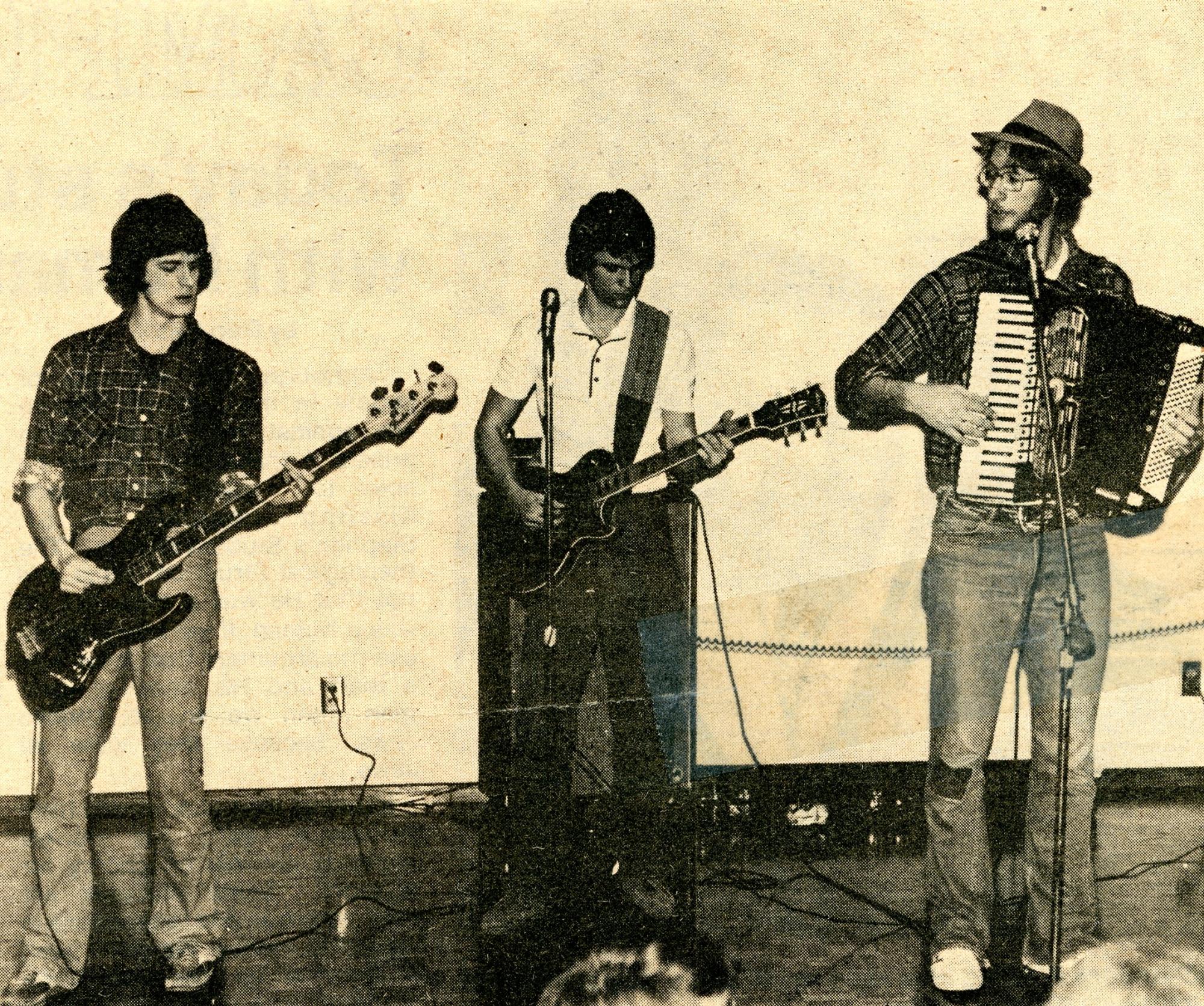
Towers residents also had a fun day in the spring semester of 1977, when bad weather led to the cancelation of classes. Food fights broke out, of course, and, despite nasty weather that made travel difficult, residents made sure that they had good supplies of liquid refreshment on hand. An improvised variety show broke out with musical acts and impersonations. The highlight of the show was Mike "Big Bird" Bredesky who, with his accordion, serenaded an appreciative audience with such classics as "In Heaven There is No Beer". The overall assessment of the day was that things were mildly rowdy, but not as bad as they could have been.
The transition to the layered arrangement brought its share of problems. Residents in the neighborhood east of Dancer Hall lodged complaints about loud music blasting out the windows. Dancer Hall residents themselves noted more noise, traffic, and rowdyism in their building, but, overall, a large majority found the new arrangement to be positive and said that they would return to Dancer Hall for another year.
In the fall of 1980, Bender Hall residents organized the game of KAOS (Killing as an Organized Sport). The object of this game was to contract for the "killing" of another of the game's participants. The "killer" would stalk and shoot his target with a rubber dart in order to fulfill his contract. The game resurfaced several more times in later years, though with modifications that required the game to be kept on campus and played only during daylight hours.
In October 1981, after two years of planning, the Bender Hall store opened. The store featured pizza and pop and was open every evening except Saturday. Hall coordinators saw the store as a convenience for residents and an employment opportunity for students.


Towers residents had their share of parties. In May 1981 they celebrated a Western Weekend with barbecued ribs; Roy Rogers, Dale Evans, and Slim Whitman sing-alike contests; cow chip throwing; and square dancing.
Parties with casino themes showed up now and then, and, in 1984, Merrill House, the third floor of Dancer Hall, put on a party with a "Chippendale" dancer theme. The Vator Monkeys, Jake Pauli and Marc Reifenrath, provided entertainment on a smaller scale with impromptu comedy, music, and stories in the Dancer Hall elevators in 1997.
Towers residents also took an interest in more serious and philanthropic activities. In 1987, Dancer Hall sponsored an educational program on organ donation. In 1997, Bender and Dancer Halls raised money to help pay for veterinary care for the pets of low income people. In 1998, Bender Hall residents Lewis Benedict and Eric Hansen put together the suMMit program that attempted to improve the lives of residents by involving them in a course of activities involving academic achievement, sound nutrition, physical fitness, and spiritual well-being. About 180 Bender Hall residents took part in this program, which awarded points for studying, going to class, watching less television, eating good food, and participating in physical activities. The program included students across campus by the spring of 2000. In the spring of 2002, residents of the eighth floor of Dancer Hall stayed "Up 'til Dawn" to raise money for St. Jude's Children's Hospital.
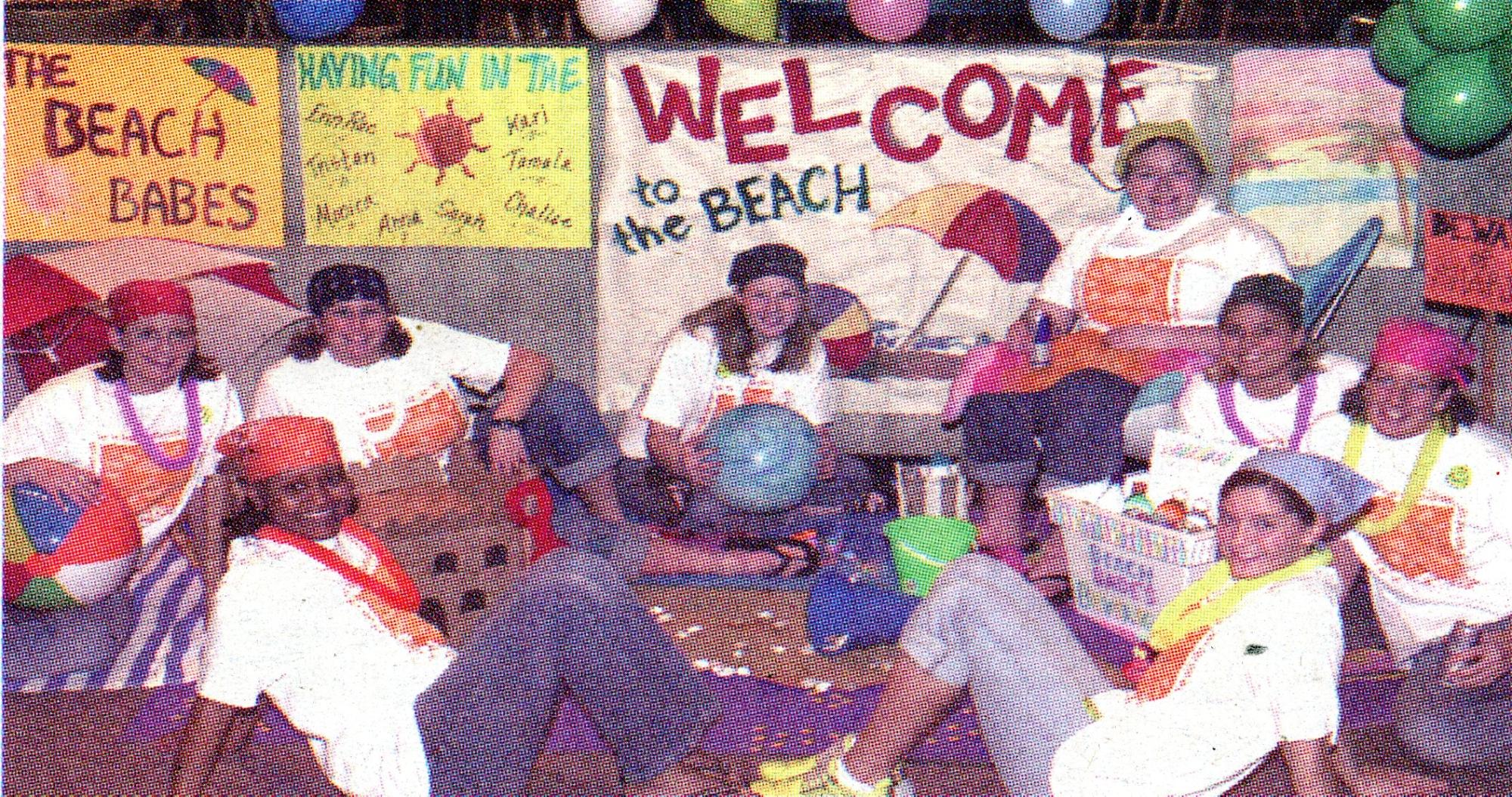
More Changes in Living Arrangements
In November 1998, the Department of Residence announced plans for living arrangements in the Towers Complex that would alternate men's and women's rooms. Initially plans called for there to be one such arrangement on a Bender Hall floor and another in Dancer Hall. Residence hall administrator Lyn Redington said that this plan was in response to demands for additional residence hall living options. As the arrangement finally worked out when it was implemented in the fall of 1999, the eleventh and twelfth floors of Bender Hall were selected for this option. Only upperclassmen or transfers would be accepted for these floors; third year resident assistants would provide staffing. For governance, there would be one male and one female executive officer. This arrangement went well during its first year, though, as in the Dancer Hall Co-ed arrangement of the 1970s, there was a concern with continuity and unity.
In spring 2003, the Department of Residence announced a decision to close the top four floors of both Dancer and Bender Halls. Officials cited lower occupancy rates in the dorms in general and the upcoming renovation of the Towers Dining Center for the closing. They hoped that Towers occupancy rates would rise once the renovation was complete. In fall 2004, the top four floors were re-opened to compensate for the closure of Shull Hall for renovation.
In spring 2004, university officials announced that Student Health Services would be located in Dancer Hall during the renovation and new construction on the Student Health Center building.
Summary
Over the course of more than forty years, thousands of residents have lived, studied, had fun, and helped to establish policies and traditions in the Towers Complex. They have faced problems and helped to solve them. Some of the history of the Towers is similar to that of other housing units. But, as Katte Winne, coordinator of Bender Hall said in 2000, "Because of their size, the building dynamics themselves make the Towers unique." She went on to say, "Somebody who is easy-going would be best suited to life in the Towers, because the Towers are a fun place to live."

Compiled by Library Assistant Susan Witthoft and volunteer Amy Peterson; edited by University Archivist Gerald L. Peterson, July 1996; substantially revised by Gerald L. Peterson, with scanning by Library Assistant Gail Briddle, October 2002; last updated, March 15, 2012 (GP); photos and citations updated by Graduate Assistant Eliza Mussmann April 12, 2023.
